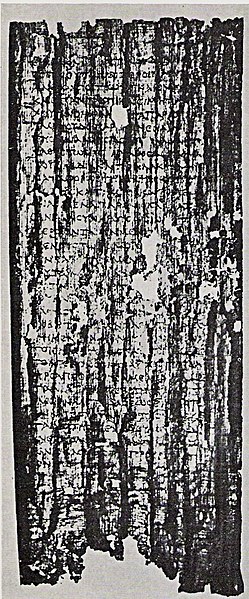Colby Cosh discusses the possibility of finally being able to read the carbonized scolls found in the buried remains of a wealthy Roman’s country villa in 1750:

Unrolled papyrus scroll recovered from the Villa of the Papyri.
Picture published in a pamphlet called “Herculaneum and the Villa of the Papyri” by Amedeo Maiuri in 1974. (Wikimedia Commons)
From the standpoint of fragile human life, a volcanic eruption is the worst possible thing that can happen anywhere in your general vicinity, up to and probably including the detonation of a nuclear weapon.
It goes without saying that pyroclastic flows are also bad for animals or buildings or vegetation … or documents. And yet: as a consequence of the eruption of Vesuvius, there exists a near-complete library of papyrus scrolls retrieved from the buried ruins of a splendid Roman villa.
The “Villa of the Papyri” in Herculaneum was found in 1750 by farmers and was quickly subjected to archeological excavation, an art then in its infancy.
These scrolls, which today number about 1,800 in all, are often described as the only known library to have physically survived from antiquity. The problem, of course, is that they have all been burned literally to a crisp, with only a few easily readable fragments here and there.
The incinerated scrolls are so sensitive that they tend to explode into a cloud of ash at the slightest touch. Occasional attempts to unravel the scrolls — which were rolled very tightly for storage in the first place — have been made over the past 300 years; the chemist Sir Humphry Davy (1778-1829), for example, gave it a shot using newfangled stuff called chlorine. But none of these projects ever came especially close to success, and they typically involved destruction of some of the “books” in the library.
In recent years 3D imaging techniques for “reading” documents like this in a non-invasive way have been making great headway. The leader in the field is a University of Kentucky computer scientist named Brent Seales, who in 2015 led efforts to read a fragile, desiccated Hebrew Bible parchment scroll dating to the third or fourth century AD.
The text was from the book of Leviticus, and proved to be a letter-for-letter match with the Torah of today — which is a disappointment to scholars from one point of view, and a finding of awesome significance from another. (It goes without saying that this scroll came from the territory of Israel, near a kibbutz: this is a fact that would, in any other political context, be regarded as a supreme affirmation of indigeneity.)
Seales has been able to “unroll” some Herculaneum scrolls and detect the presence of inks using CT scanning, but reading the pages is a profound challenge. Roman ink was carbon-based, meaning researchers are trying to “read” traces of carbon on carbonized pages rolled up into three dimensions.



